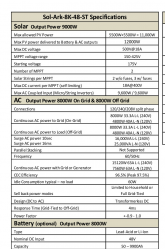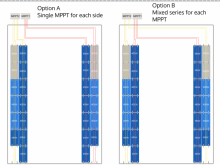mrdavvv
Solar Enthusiast
- Joined
- Jan 14, 2020
- Messages
- 404
Hello!.
So the setup is:
- 4 x 400W panel (Gray), 6 x 405W (Light blue), and the rest in 410W (Blue). Total of 26 PV.
- East west orientation
- Solark / Deye 8K (10K of PV max).
This are our option, put an east and west string in a single MPPT:

Or put all east in a single MPPT, and same for al west:

So the setup is:
- 4 x 400W panel (Gray), 6 x 405W (Light blue), and the rest in 410W (Blue). Total of 26 PV.
- East west orientation
- Solark / Deye 8K (10K of PV max).
This are our option, put an east and west string in a single MPPT:

Or put all east in a single MPPT, and same for al west:






